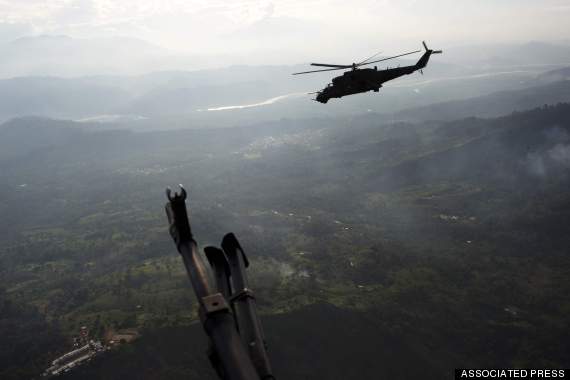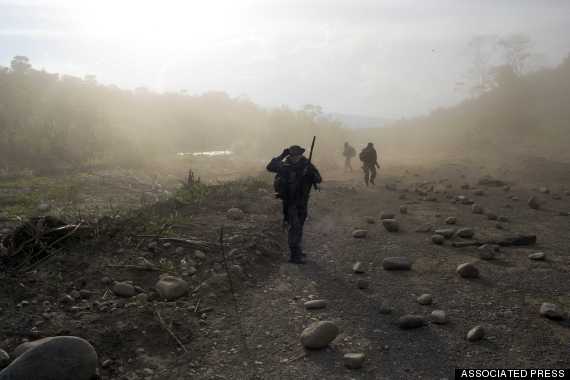PICHARI, Peru (AP) - The dynamiting of clandestine airstrips by Peruvian security forces in the world's No. 1 coca-growing valley cuts into profits but hardly discourages cocaine traffickers who net tens of thousands of dollars with each Bolivia-bound flight.
As authorities wound up a 54-airstrip "cratering" mission, Peru's counternarcotics police chief Gen. Vicente Romero told reporters that traffickers pay local villagers up to $100 each to fill the holes blasted into the landing strips that dot the flood plain of the vast and verdant Apurimac and Ene river valley.
Two of the landing strips targeted in the latest operation have each been repaired four times this year, Romero said on Friday. Sometimes, the 500-meter airstrips are fixed overnight.
 In this Sept. 19, 2014 photo, a military helicopter flies over the VRAEM region, in Pichari, Peru. (AP Photo/Rodrigo Abd)
In this Sept. 19, 2014 photo, a military helicopter flies over the VRAEM region, in Pichari, Peru. (AP Photo/Rodrigo Abd)
An average of about four or five small planes fly daily into Peru from Bolivia, picking up about 300 kilograms each of coca paste worth about a third of a million dollars in Bolivia, where it is further refined, authorities say. Romero says pilots earn from $10,000 to $25,000 per flight.
The border has no radar coverage and the neighboring nations' air forces are limited so drug flights can only be intercepted on the ground. Romero said 14 planes have been seized this year.
Last week, Peruvian and Bolivian officials agreed to share information in real time on cross-border drug flights. They did not, however, divulge details.
 In this Sept. 19, 2014 photo, counternarcotics officers walk in a clandestine airstrip strewn with boulders, in the Apurimac, Ene and Mantaro River Valleys, or VRAEM, the world's No. 1 coca-growing region, in Junin Peru. (AP Photo/Rodrigo Abd)
In this Sept. 19, 2014 photo, counternarcotics officers walk in a clandestine airstrip strewn with boulders, in the Apurimac, Ene and Mantaro River Valleys, or VRAEM, the world's No. 1 coca-growing region, in Junin Peru. (AP Photo/Rodrigo Abd)
Peru's anti-drug police, known as Dirandro, says the country produces 450 tons of cocaine a year, half of which leaves the country on small Bolivia-bound narco planes.
Most Peruvian cocaine ends up in Brazil and Europe.
The so-called air bridge between Peru and Bolivia has been especially active since 2011, the year before the U.S. Drug Enforcement Administration and the United Nations said Peru surpassed Colombia as the world's top cocaine producer.
Peru halted shoot-downs of suspected drug flights in 2001 after a Peruvian air force jet mistakenly fired on a plane carrying U.S. missionaries, killing a woman and her infant daughter.
 In this Sept. 19, 2014 photo, the Ene river is seen from a military helicopter as it flies over the Apurimac, Ene and Mantaro River Valleys, or VRAEM, the world's No. 1 coca-growing region, in Pichari, Peru. (AP Photo/Rodrigo Abd)
In this Sept. 19, 2014 photo, the Ene river is seen from a military helicopter as it flies over the Apurimac, Ene and Mantaro River Valleys, or VRAEM, the world's No. 1 coca-growing region, in Pichari, Peru. (AP Photo/Rodrigo Abd)
__
Associated Press writer Frank Bajak contributed to this report from Lima, Peru
